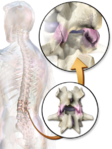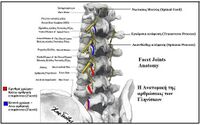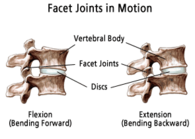Facet Arthrosis: Difference between revisions
Niha Mulla (talk | contribs) No edit summary |
Niha Mulla (talk | contribs) No edit summary |
||
| Line 47: | Line 47: | ||
== Risk factors == | == Risk factors == | ||
'''Possible risk factors include:'''<ref name=":1" /> | '''Possible risk factors include:'''<ref name=":1" /><ref>Eubanks JD, Lee MJ, Cassinelli E, Ahn NU. Prevalence of lumbar facet arthrosis and its relationship to age, sex, and race: an anatomic study of cadaveric specimens. Spine. 2007 Sep 1;32(19):2058-62.</ref> | ||
* Age: Common in older people. | * Age: Common in older people. | ||
| Line 54: | Line 54: | ||
== Signs and symptoms == | == Signs and symptoms == | ||
'''Pain is the most common symptom of facet arthrosis; while nature of pain associated with the condition may vary:'''<ref name=":1" /><ref name=":2" /><ref>Berry J. Facet arthropathy: Symptoms, causes, and risk factors. Morrison W, editor. Medical News Today. MediLexicon International; 2017 December 19. Available from: https://www.medicalnewstoday.com/articles/320355</ref> | '''Pain is the most common symptom of facet arthrosis; while nature of pain associated with the condition may vary:'''<ref name=":1" /><ref name=":2" /><ref>Berry J. Facet arthropathy: Symptoms, causes, and risk factors. Morrison W, editor. Medical News Today. MediLexicon International; 2017 December 19. Available from: https://www.medicalnewstoday.com/articles/320355</ref><ref>Eisenstein SM, Parry CR. The lumbar facet arthrosis syndrome. Clinical presentation and articular surface changes. The Journal of Bone and Joint Surgery. British volume. 1987 Jan;69(1):3-7.</ref> | ||
* Back pain and/or neck pain (depending on area of involvement of facet arthrosis) and the pain is aggravated on bending, leaning backward, when twisting sideways, lifting objects, or standing. | * Back pain and/or neck pain (depending on area of involvement of facet arthrosis) and the pain is aggravated on bending, leaning backward, when twisting sideways, lifting objects, or standing. | ||
| Line 64: | Line 64: | ||
== Evaluation and diagnosis of facet arthrosis == | == Evaluation and diagnosis of facet arthrosis == | ||
* X-rays, and computed tomography (CT) scans and magnetic image resonance (MRI) show if arthrosis has caused any visible damage to your facet joints and surrounding tissue.<ref name=":0" /> | |||
* A technique called a diagnostic medial branch block is often the surest way of obtaining a diagnosis of facet arthrosis. Medial branch blocks are injections, that are inserted near the medial nerve, of the facet joint.'''''' A set of two injections are performed at different times. If both injections cause the pain to stop for a period of time by at least 80%, it’s usually a confirmation of facet arthrosis. This techniques is also used as a from of treatment by doctors to teat facet arthrosis.<ref name=":0" /><ref name=":1" /><ref name=":2" /><ref>Park D, Throckmorton T, Fischer S. Spinal injections - orthoinfo - AAOS (The American Academy of Orthopedic Surgeons) 2022 February. Available from: https://orthoinfo.aaos.org/en/treatment/spinal-injections/</ref> | |||
== Differential Diagnosis == | == Differential Diagnosis == | ||
'''Differential diagnoses for facet arthrosis include:''' | '''Differential diagnoses for facet arthrosis include:'''<ref>Mann SJ, Viswanath O, Singh P. [https://www.ncbi.nlm.nih.gov/books/NBK538228/ Lumbar facet arthropathy.]</ref> | ||
* Herniated disc | * Herniated disc | ||
Revision as of 18:38, 11 May 2022
This article is currently under review and may not be up to date. Please come back soon to see the finished work! (11/05/2022)
Original Editor - Niha Mulla
Top Contributors - Niha Mulla
Definition and introduction[edit | edit source]
Facet arthrosis is a painful arthritis-like condition of the spine caused by degeneration of the joints between the spinal bones.
The spine is made up of vertebrae and between each vertebra are two facet joints cushioned by cartilage and lubricated by synovial fluid. These facet joints run alongside the vertebrae posteriorly and and help with twisting and turning motions of the spine. [1][2][3]
Clinical relevance[edit | edit source]
Facet joints degenerate, wear down with age, leading to facet arthrosis. The cartilage of the facet joints, wears down and gets damaged due to trauma or/and aging causing friction in-between joints leading to inflammation, swelling and stiffness; which further causes discomfort and extreme pain. [1][2][3]
Causes[edit | edit source]
Aging is one of the most common causes of facet arthrosis as spinal degeneration is the principal cause of facet arthrosis.
Other reasons that can cause facet arthrosis are as follows: [1][2][3]
- Osteoarthritis of facet joint
- Wear and tear of the facet joints
- Direct trauma to the facet joint, such as a car accident or fall.
- Microtraumas to the area
- Obesity
- Poor body mechanics, such as bad posture
- Synovial cyst which is a fluid-filled sac on the spine, which in turn puts pressure on the spinal nerves.
- Damaged spinal discs from injury.
- Rheumatoid arthritis: This condition causes damages to the facet joints, especially, mid-lumbar and lower lumbar areas.
- Torn ligaments
- Disc problems
Pain in the lower back can result from numerous causes. According to Dan Brennan, MD; in his article “What Is Facet Arthrosis?” on Webmed, other low back pain can be differentiated from facet joint pain or facet arthrosis by watching for the following symptoms:[1]
- Lower back pain that is worse in the morning
- Pain that increases during times of inactivity
- Pain during spinal flexion or while performing a twisting motion
- Pain that usually stays in one place, but can radiate to other areas of the body
Risk factors[edit | edit source]
Possible risk factors include:[2][4]
- Age: Common in older people.
- Gender/Sex: More common in females than in males.
- Obesity: Three times higher risk in people with body mass index of 25-30 kg/m2 while five times higher risk in people with body mass index of 30-35 kg/m2.
Signs and symptoms[edit | edit source]
Pain is the most common symptom of facet arthrosis; while nature of pain associated with the condition may vary:[2][3][5][6]
- Back pain and/or neck pain (depending on area of involvement of facet arthrosis) and the pain is aggravated on bending, leaning backward, when twisting sideways, lifting objects, or standing.
- Constant dull aching pain on back and/or neck on one or both sides.
- Pain centered in a specific area of the spine.
- Pain worsens after sleep or rest.
- Pain is relieved with sitting or changing positions.
- Stiffness around part of the back and/or neck (depending on area of involvement of facet arthrosis)
Evaluation and diagnosis of facet arthrosis[edit | edit source]
- X-rays, and computed tomography (CT) scans and magnetic image resonance (MRI) show if arthrosis has caused any visible damage to your facet joints and surrounding tissue.[1]
- A technique called a diagnostic medial branch block is often the surest way of obtaining a diagnosis of facet arthrosis. Medial branch blocks are injections, that are inserted near the medial nerve, of the facet joint. A set of two injections are performed at different times. If both injections cause the pain to stop for a period of time by at least 80%, it’s usually a confirmation of facet arthrosis. This techniques is also used as a from of treatment by doctors to teat facet arthrosis.[1][2][3][7]
Differential Diagnosis[edit | edit source]
Differential diagnoses for facet arthrosis include:[8]
- Herniated disc
- Discogenic pain syndrome
- Paraspinal muscle/ligament sprain/strain
- Spondylosis/spondylolysis/spondylolisthesis
- Rheumatoid arthritis (more common in cervical)
- Seronegative spondyloarthritis (most commonly ankylosing spondylitis, psoriatic arthritis, reactive arthritis)
- Gout
- Diffuse idiopathic skeletal hyperostosis
- Sacroiliac joint dysfunction (common in lumbar facet arthrosis)
- Fascia dysfunction
- Neoplasm
- Fibromyalgia
Treatment and prognosis[edit | edit source]
Complications[edit | edit source]
Physical therapy interventions[edit | edit source]
Prevention[edit | edit source]
- x
or
- numbered list
- x
References[edit | edit source]
- ↑ 1.0 1.1 1.2 1.3 1.4 1.5 Brennan D. Facet arthrosis: What is it and what causes it? WebMD; 2021 June 15. Available from: https://www.webmd.com/arthritis/what-is-facet-arthrosis
- ↑ 2.0 2.1 2.2 2.3 2.4 2.5 Rohini Radhakrishnan. Is facet arthropathy serious? causes & symptoms. MedicineNet; 2021 November 17. Available from: https://www.medicinenet.com/is_facet_arthropathy_serious/article.htm
- ↑ 3.0 3.1 3.2 3.3 3.4 Eustice C. Learn how facet arthropathy causes low back pain. Verywell Health; 2022 February 2. Available from: https://www.verywellhealth.com/facet-arthropathy-treatment-190440
- ↑ Eubanks JD, Lee MJ, Cassinelli E, Ahn NU. Prevalence of lumbar facet arthrosis and its relationship to age, sex, and race: an anatomic study of cadaveric specimens. Spine. 2007 Sep 1;32(19):2058-62.
- ↑ Berry J. Facet arthropathy: Symptoms, causes, and risk factors. Morrison W, editor. Medical News Today. MediLexicon International; 2017 December 19. Available from: https://www.medicalnewstoday.com/articles/320355
- ↑ Eisenstein SM, Parry CR. The lumbar facet arthrosis syndrome. Clinical presentation and articular surface changes. The Journal of Bone and Joint Surgery. British volume. 1987 Jan;69(1):3-7.
- ↑ Park D, Throckmorton T, Fischer S. Spinal injections - orthoinfo - AAOS (The American Academy of Orthopedic Surgeons) 2022 February. Available from: https://orthoinfo.aaos.org/en/treatment/spinal-injections/
- ↑ Mann SJ, Viswanath O, Singh P. Lumbar facet arthropathy.









